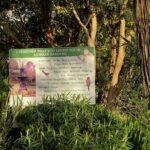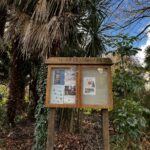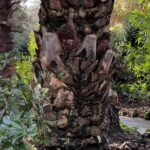
As I left my hotel on a January morning, I made my way toward Morrab Library in Penzance. The air was fresh, and the sunlight added a pleasant warmth, making the day feel more inviting than typical winter weather. I knew I’d arrive before the doors opened, so I took the opportunity to wander through the gardens that surround the library.
The subtropical climate was immediately evident; despite the winter season, the gardens were alive with so many green plants. It was a surreal sight—palm trees swaying gently in the breeze, a far cry from the English landscape I had imagined my ancestors inhabiting. The size of the palms were some of the largest I’ve ever seen. A sign near the entrance illustrates ‘creatures that you might see in Morrab Gardens’ – quite an ecosystem.
This visit was a highlight of my trip, bringing together not just names, places, and dates, but also a deeper understanding of the everyday lives and challenges my ancestors faced. There’s a unique insight you gain when you walk the same paths they once did, seeing firsthand the environment that shaped their character.
Over two years ago, as I delved more into the Cornish social history, I came across Dr. Charlotte MacKenzie on Twitter, whose account, fittingly named @HistoryCornwall, captivated me. An award-winning author and independent researcher, Charlotte was once a senior university lecturer in history.
Eager to dive deeper into her work, I found her book, Merchants and Smugglers in 18th Century Cornwall, published in 2019. I initially ordered it as an e-book, hoping to search for familiar names and phrases. The content was so compelling that I couldn’t resist getting a print copy as well.
There, in black and white, were the names I had grown so familiar with—Blewett, Edwards, Dewen, Cornish, and Lemon. Charlotte’s meticulous research had woven stories of my family into the broader fabric of Cornish society. She had already explored many of the records I was planning to pull from the Cornwall Archives at Kresen Kernow. Her work brought new life to the stories of my 6x and 7x great-grandfathers, the first two Samuel Lemons, information I had never come across before.
As any seasoned family historian knows, conflicting information is part and parcel of genealogical research. It’s why I’ve become strict about what I accept into my tree as fact, carefully filtering through family lore until I can verify it with original or archival sources. Charlotte’s work, with its well-documented sources, has helped me uncover new records that I was able to later review at Kresen Kernow.
Taking a chance, I reached out to Charlotte on Twitter, asking if she’d be interested in meeting me in Penzance to discuss my family history. To my delight, she agreed, suggesting we meet at the Morrab Library—a place I hadn’t yet explored. She also sent me a link to their library catalogue, and I was thrilled to discover that they held customs books from the Isles of Scilly, foreshadowing another family connection.
We met on the steps of the library, exchanged greetings, and quickly ducked inside. Morrab House, built in 1841, has a rich history of its own, having served as the home of Charles Campbell Ross, a banker, local council member, and MP for St Ives.
Inside, floor-to-ceiling bookshelves lined the walls of room after room. Charlotte guided me through each space before we settled in a research room. The library has done a remarkable job preserving its history, with rooms named after significant figures and setup ready for people to dive into research. One of my favourites was a room which contains the Elizabeth Treffry Collection on Women in Cornwall & Isles of Scilly. Coming down the stairs my jaw dropped as I saw the gallery of photos and period paintings hung all around – remarkable! As we talked, I was captivated by Charlotte’s deep knowledge of Cornish history and her insights into the Lemon family’s connection to the region.
One revelation that particularly struck me was Cornwall’s ties to the slave trade, a piece of history I had never encountered in my research. It was a sobering reminder of the complexities of the past and how much there is still to learn.
A week into my trip, I found myself falling in love with the area. In a way that’s hard to explain, it felt like home. Charlotte and I decided to stretch our legs, taking a walk to a local real estate agent’s office to browse property listings. The idea of having a place to call my own in Cornwall began to take root and is something I’d like to see happen in the future.
Eventually, Charlotte left me to delve into the library’s records on my own. Before parting, we made plans to meet again in Marazion to walk the causeway to St Michael’s Mount and explore my family’s history there. Although I wasn’t feeling well enough the next day to make the journey, I can hardly wait for my next trip to Cornwall to continue our conversation.
Charlotte’s expertise has been invaluable to my research, and I wholeheartedly recommend her books to anyone interested in Cornish history or looking for a captivating read. Personally, I can’t get enough of them.
Click here to visit her Lulu publishing site
Click here to visit her Amazon storefront
Titles
- Cornish mysteries
- Cornish legends
- Women Writers and Georgian Cornwall
- Merchants and smugglers in eighteenth century Cornwall
- Cornish medics
- Mary Broad the documentary
- The travel writer Mary Ann Parker
- Master of Bedlam: The Transformation of the Mad-Doctoring Trade (with Andrew Scull and Nicholas Hervey)
- The Cornish Mariner Captain Joseph Banfield
- The Ellis family in Cornwall
- The Ellis Breweries at Helston and Hayle









